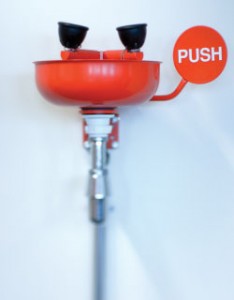Protect your peepers: How to prevent and treat workplace eye injuries
 The human eye is a complex and intricate organ that provides us with the invaluable sense of sight. Eyes allow us to take in the majority of information we obtain about the environment around us.
The human eye is a complex and intricate organ that provides us with the invaluable sense of sight. Eyes allow us to take in the majority of information we obtain about the environment around us.
Of human body organs, the eyes are considered second only to the brain in complexity. Each eye is made up of more than 2 million working parts and is capable of detecting more than 10 million colors. The human eye can process 36,000 bits of information every hour, and its lens is faster than any existing camera lens.
Protecting the eyes is crucial
Given the eyes’ complexity, size and location, it is easy to understand that they are also extremely vulnerable to injury. Eyes are susceptible to hazards encountered every day outside of work, such as flying or falling objects, sand and dust particles, chemicals and vapors, and even ultraviolet light. Likewise, many workplace environments contain potential eye hazards.
For this reason, national standards are in place to protect individuals’ eyes at work. In the United States, the Occupational Safety and Health Administration (OSHA) requires employers to provide employees with suitable eye and face protection “whenever necessary to protect against chemical, environmental, radiological or mechanical irritants and hazards.”
While OSHA publishes the general framework for eye protection and emergency eyewash workplace practices and hazard assessments, it refers to the American National Standards Institute (ANSI) for performance requirements relating to personal protective equipment and eye safety.
ANSI Z87.1-compliant eye protection in the form of safety spectacles or goggles is suitable protection from most common hazards. Many employers supplement ANSI guidelines by implementing eye safety protocols above and beyond national standards to meet their site’s specific needs and safety goals. Together, these national and corporate-level efforts have successfully reduced the number of occupational eye injuries in recent decades.
Still, workplace eye injuries are common. According to OSHA, more than 2,000 people injure their eyes at work each day in the U.S. Roughly one in 10 of these individuals requires one or more missed workdays to recover, and 10 to 20 percent of all occupational eye injuries result in temporary or permanent vision loss, OSHA says.
The cost of lost vision to an individual is immeasurable, spanning medical expenses, diminished quality of life and the reduced ability to earn a living. Furthermore, workplace eye injuries cost employers more than $467 million in direct costs per year, according to the U.S. Bureau of Labor Statistics. Once indirect costs such as legal fees, judgments and training new workers
are factored in, that estimated total exceeds $934 million per year, according to Prevent Blindness America.
Proper injury response is imperative
When an eye injury occurs, proper and immediate treatment is the best defense. The ANSI Z358.1-2009 standard for “Emergency Eyewash and Shower Equipment” establishes a universal minimum performance and use requirement for all eyewash and drench shower equipment used for the treatment of the eyes, face and body of a person who has been exposed to hazardous materials and chemicals.
ANSI requires that the first step following chemical contact of any kind with the eyes — including caustics, acids, solvents and other hazardous materials — is immediate flushing of the eyes with water. According to the standard, such water may be any potable (drinking) water, preserved water, preserved buffered saline solution or other medically acceptable solution.
The first 10 to 15 seconds after exposure to a hazardous substance, especially a corrosive substance, are critical. Delaying treatment, even for a few seconds, may cause serious injury. For this reason, ANSI calls for eyewash stations to be located within a 10-second walk from the hazard.
To ensure easy access to a station within 10 seconds, it must be located on the same level as the hazard with no steps, stairs or obstructions. In the case of strong caustics and strong acids, eyewash must be located immediately adjacent to the hazard. The area surrounding the station should be well lit and marked with a sign that is highly visible to everyone served by it.
Once an injured worker reaches the station, ANSI calls for the eyes to be flushed continuously for a full 15 minutes with fluid flowing at a rate of 0.4 gallons per minute for portable and plumbed eyewash stations. This fluid must be delivered at a tepid temperature, ranging between 60 and 100 degrees Fahrenheit, in order to safely treat eyes without causing further injury.
Fluid that is too cold may prevent workers from flushing for the full 15 minutes, and fluid exceeding 100 degrees can harm the eyes and even exacerbate chemical reaction with the eyes and skin.
Brian Palmer, superintendent at Shoreacres in Lake Bluff, Ill., says he and his crew have been fortunate and have never had to use their emergency eye wash station. But they are prepared to in the event an emergency occurs.
He adds that his entire crew of 21 is good about wearing the proper eye protection, be that protective glasses or face shields.
“It’s not a big deal (to the crew),” Palmer says, “but if you have a guy lose an eye, you’re going to pay a lot more for worker’s compensation than you would to have just had the proper safety equipment.”
John Namciu, superintendent at Shaker Heights (Ohio) CC reminds his crew how quickly an eye injury can happen.
“There are a lot of dangers on a golf course, from debris off a weed eater to an errant golf ball,” he says. “In this business, you have to keep your head on a swivel.”
Information for this article courtesy of Honeywell Safety Products.
Image: istockphoto.com (pidjoe, gavran333)








